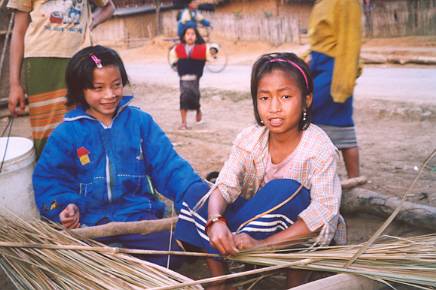
Making thatched roof panels in Naw Maw Village, Laos

Making thatched roof panels in Naw Maw Village, Laos
Hello from the far north of Laos with Bill and Bessie Too
Luang Nam Tha,
Lao PDR
17 January 2003
I am writing this at a solar-powered Internet cafe in the far north of Laos! The little town of Luang Nam Tha sits beside the Nam Tha River amongst rice fields and is surrounded by high green mountains.
During the four days of cycling from Luang Prabang, we climbed and twisted along the mountain roads to this remote area. On the first day we followed rivers—up along the Mekong, right up the Nam Ou (which had the same muddy red color as the Mekong), left up the clear green Nam Nga, then right up a little creek toward the junction village of Pak Mong. The road really hit the hills the next day with a 30-km warm-up climb, a great descent, then another climb—only 16 km this time—and a final speedy run into Udomxai. I was tired, but a big Chinese dinner quickly restored my energy. Here and in Pak Mong, I almost thought I was in China, as so many Chinese run businesses and sell Chinese merchandise. Out in the villages, though, we passed tribal areas where many folks dress in traditional clothing, including brightly colored embroidery on the women's garments. Some of the women were busily spinning or weaving beside their little wood and bamboo houses.
From Oudomxai, it was back into the mountains on a deteriorating road. We halted for the night at a group of villages called Na Maw, such a nice place that some backpackers had stopped over here too. Today we continued north to Na Toei, the turnoff for the China border crossing at Boten, only 20 km away. China will be another trip—I've heard many good things about travel in Yunnan province. We turned west on Hwy. 3 and wound through more mountains to the wide valley of Luang Nam Tha town. It's the capital of the province of the same name, which is bordered by China on the north and Myanmar (Burma) on the northwest. The province has 39 classified ethnicities—more than any other in the nation! Trekking tours have started in the region, something I'd like to join on another trip.
Tomorrow we take a rest day. From Luang Nam Tha the road goes from bad to worse! Although the past two days have been a bumpy mix of gravel and pavement, from here on to Huay Xai the road is rough and unpaved. This 195 km will be our last stretch of Laos, as Huay Xai is the border town where we ferry across the Mekong to Thailand. Laos has been a great ride—a very friendly place different from any other.
The end of a great ride with Bill and Bessie Too
Bangkok, Thailand
26
January 2003
The pavement ran out at the south edge of Luang Nam Tha, and we wouldn't be seeing any more any time soon. This turned out to be a full-service dirt road—killer hills, nasty ruts, mud bogs, creek fords, and dust. Mountains cloaked in greenery and fast-running streams were our companions along the way, as well as the ever-friendly village kids calling out "hello!"
Some cyclists I spoke with had done this stretch in two days, but they found doing so very tough. I elected to spread out the ride into three days and enjoy it. Much of the beautiful forests along the way receive protection in the Nam Hin National Biodiversity Conservation Area. Sections had been cleared by hill tribes in slash-and-burn cultivation, an extremely arduous and unreliable method of growing rice, and they were now reverting to forest.
When the large village of Vieng Phukka came into view, we had ridden about 70 km and were ready to call it a day. Of the three guesthouses here, I chose the one with little bamboo bungalows. People in the kitchen invited me to join them for a dinner of sticky rice, cooked greens, and cow innards. I declined the guts, but enjoyed the spinach-like vegetable along with the rice and a couple of fried eggs. Pounding bass of Lao pop blasted out from a bar across the road, detracting from the peaceful riverside setting, though I was too tired to care much. In went the earplugs and out went the lights.
An hour and a half down the road the next morning, we passed an open-pit coal mine run by a Thai company. The road improved (no more mud bogs or unbridged streams), but dust kicked up by the occasional coal trucks had me pulling on a dust mask. The scenery got even better as the road followed high ridges with splendid panoramas of rugged mountains extending to the horizon. After dinner at a rare roadside restaurant, I started thinking about finding the perfect place to camp. No guesthouses or towns were to be found, so I looked for a grassy secluded spot with running water nearby. I finally found it and pitched my little tent beside a bamboo grove. Nighttime cold enveloped us and condensation on the leaves began to drip, sounding much like rain despite the starry sky above.
Usually fog formed in the early mornings this time of year in northern Laos, but the sun came out early and sped us along the way toward the Mekong River and Huay Xai. The mountains presented some last big challenges before receding behind us as we approached the river plain. Mixed feelings arose on seeing the wide muddy Mekong—good food and a hot shower waited, but the long, enjoyable ride the length of Laos was at an end.
After a big breakfast in Huay Xai the next morning, we hopped into a motorized canoe and cruised across to Chiang Khong, a sleepy town not much different from its Lao counterpart. We hadn't completely left Laos, as it remained in view over the next three days as we cycled idyllic backroads upstream along the Mekong. We spent a day at Chiang Saen, another slow-paced river town, where ruins of ancient brick walls, monasteries, and chedis poke up here and there among the modern buildings. Chiang Saen had once been a center of the Lanna kingdom beginning in the 14th century. A museum has many Buddhas and other art from that long-ago time.
The center of the infamous "Golden Triangle" lies just 9 km farther north. We couldn't resist and headed up along the misty Mekong to Sok Ruap, a touristy village where the borders of Thailand, Laos, and Myanmar meet. I had a hefty breakfast buffet at the Imperial Golden Triangle Resort while watching the fog dissolve around the mountains of Laos and Myanmar. Satiated, I turned south to Chiang Rai, the capital of Thailand's northernmost province. Traffic gradually increased during the day, but like most Thai highways, Hwy. 1 has a wide shoulder. Chiang Rai marked the end of the long ride that had begun in Bangkok more than two months before and had taken us over extremes of climates and terrain, but always with friendly people along the way.
A leisurely day of sightseeing in Chiang Rai took us to yet another limestone cave with a big Buddha image inside and to several glittering monasteries, including Wat Phra Kaew. You may have heard of Bangkok's famous Temple of the Emerald Buddha; the image's long journey once included a stay at Chiang Rai. Today a modern replica of the Emerald Buddha—one millimeter shorter—of Canadian jade stands in a shrine at the Chiang Rai temple.
After the sun went down, we climbed aboard a V.I.P. bus for the ten-hour ride south to Bangkok. The bus had lots of legroom, a smooth ride, and a stewardess who handed out towelettes, snacks, and soft drinks. Quite a contrast to the tortuous bus ride from Mandi to Delhi at the end of our Indian ride!
Lots of backpackers are roaming the streets of Bangkok, and we had a hard time finding a place to stay. After hearing "full" in two popular areas, we got an air-conditioned room in the 88 Hotel, an old Thai-Chinese place for a bargain $6/night. "Temporary" rooms were advertised too, but at least the hotel was quieter than those in the backpacker enclaves!
NORTHERN LAOS PHOTOS
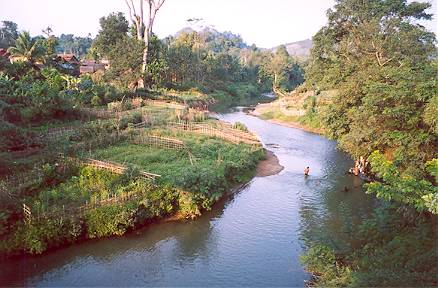
Huay On River at Na Maw Village, southeast of Luang Nam Tha
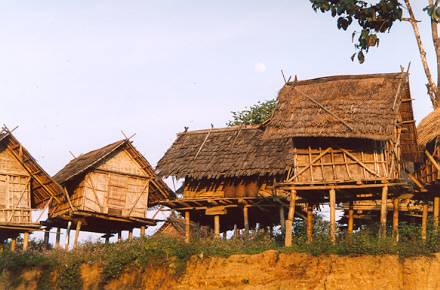
Rice-storage sheds at Na Maw Village
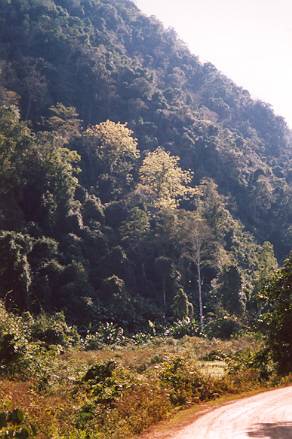
Dense forests still cover the mountains in much of Laos.
NORTHERN THAILAND PHOTOS
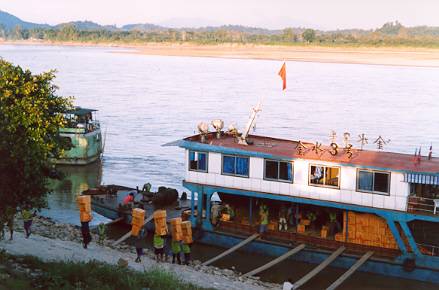
Chinese boats on the Mekong: Boxes of fruit and manufactured goods go back
and
forth between this dock in Chiang Saen and Yunnan Province in China.
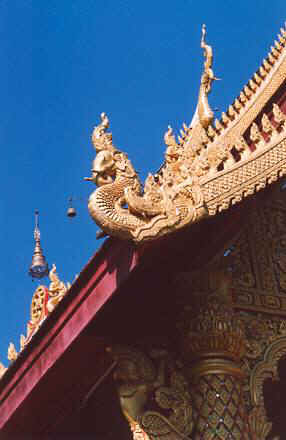
Unusual elephant-headed snakes on the roof of Wat Phakhaopan in Chiang Saen.
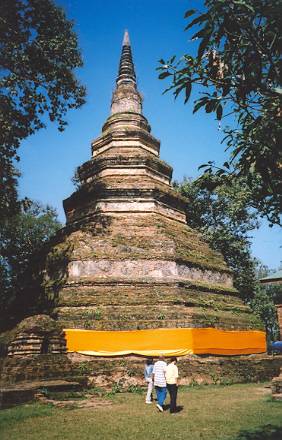
This 18-meter Lanna-style chedi, behind the ruins
of Wat Chedi Luang, is the
largest in Chiang Saen.
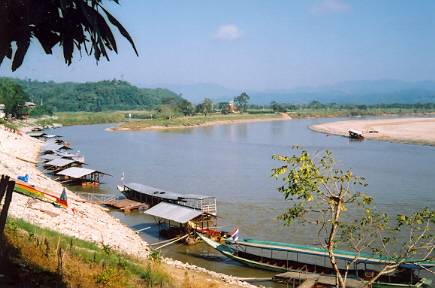
The Golden Triangle!
We're standing in Sop Ruak, Thailand, and
looking north. Myanmar (Burma) is in the
center between the Nam Ruak and Mekong
Rivers. Laos is on the right across the Mekong.
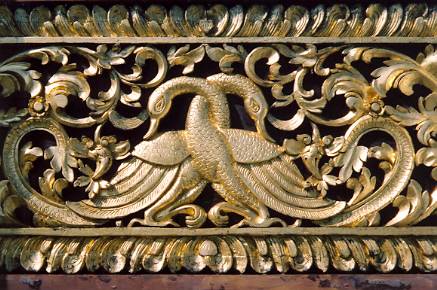
Detail of Wat Chom Chang, on a hilltop northwest of Chiang Saen
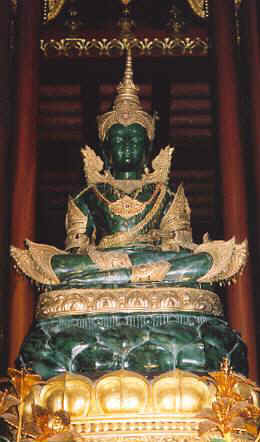 Made
of Canadian jade, this beautiful Buddha is enshrined at Wat Phra Kaew in Chiang
Rai. It's 65.9 cm tall, just 0.1 cm less than the original Emerald Buddha, revealed
here in 1434 when lightning split open a chedi.
Made
of Canadian jade, this beautiful Buddha is enshrined at Wat Phra Kaew in Chiang
Rai. It's 65.9 cm tall, just 0.1 cm less than the original Emerald Buddha, revealed
here in 1434 when lightning split open a chedi.
BANGKOK PHOTOS
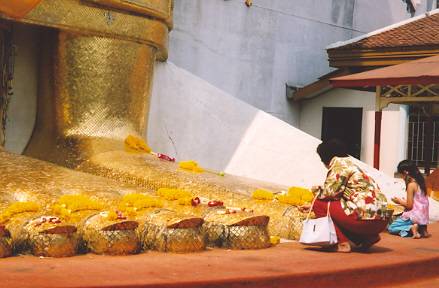
Praying at the feet of a 32-meter standing Buddha at Wat Intharawihan in Bangkok.
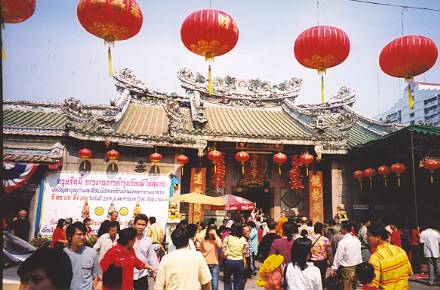
The courtyard of Wat Mangkon Kamalawat (Neng Noi Yee) in Bangkok's Chinatown
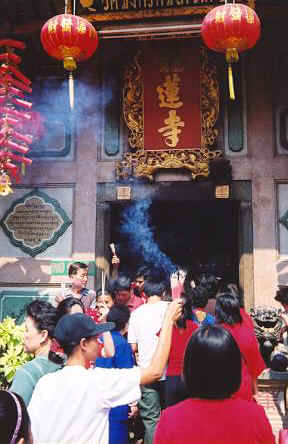
Entering the temple at Wat Mangkon Kamalawat
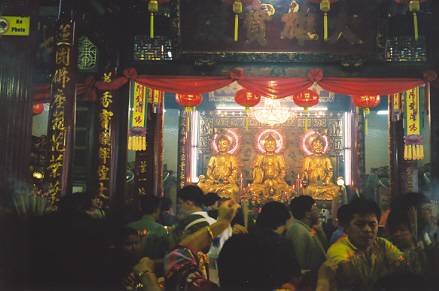
Room after room of Wat Mangkon Kamalawat displayed Buddha images,
bodhisattvas,
and guardian figures. It's one of the largest temples in Bangkok's Chinatown.
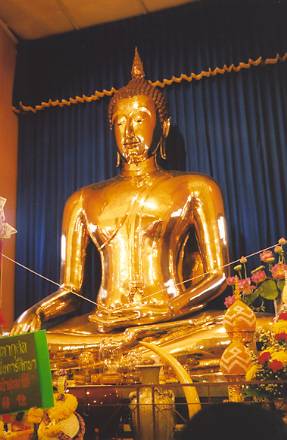 Golden Buddha at Wat Traimit in Bangkok's Chinatown.
Golden Buddha at Wat Traimit in Bangkok's Chinatown.
This gleaming statue in the
graceful Sukhothai style apparently had been encased
in a plaster coating hundreds
of years ago to conceal it during a Burmese invasion.
Only in the 1960s did the
statue's true nature become unveiled when the plaster
cracked during a move within
the temple compound.
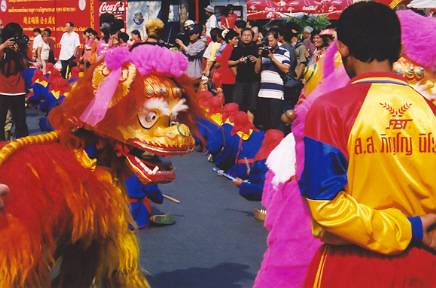
Lions dance to welcome the Chinese New Year in Chinatown.
The street festival
took place Feb. 1-2, 2003
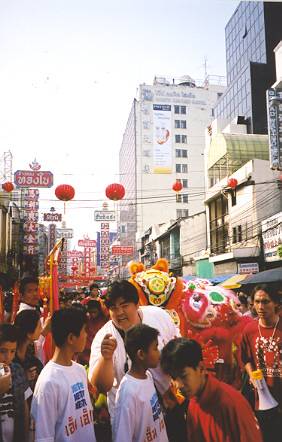 Food
and entertainment galore
Food
and entertainment galore
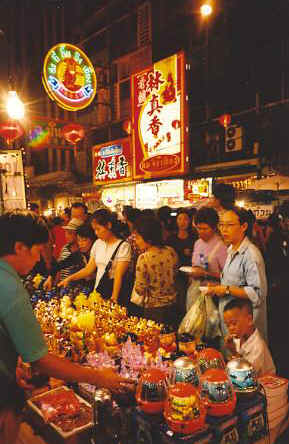 A
street market sells all kinds of non-essentials!
A
street market sells all kinds of non-essentials!